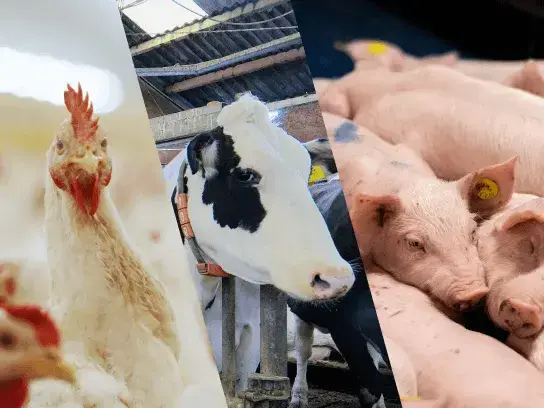Lighting plays a crucial role in livestock farming, directly impacting animal health, welfare, and production efficiency. Over time, however, the efficiency of lighting systems deteriorates, reducing their effectiveness and ultimately costing farmers money.
Investing in a state-of-the-art lighting system is a relatively small cost compared to the overall expenses of running a poultry or pig house—but the returns can be significant.
Lighting Efficiency Declines Over Time
Many livestock farms still operate with lighting systems that are 10 years old or more. What many farmers don’t realize is that the efficiency of these systems gradually decreases, meaning that animals are not receiving optimal light levels. This can negatively impact their behavior, growth rates, and overall well-being.
In poultry and pigs, poor lighting conditions have been linked to increased stress, reduced feed conversion efficiency, and higher mortality rates.
Farmers focused on maximizing productivity should consider the cost of sticking with an outdated system. A drop in efficiency over time doesn’t just mean higher electricity bills—it means lower production yields and a greater risk of welfare-related issues.
The Cost of Investment vs. The Cost of Inefficiency 
While upgrading to an advanced lighting system may seem like a financial burden, the reality is that the investment is minimal compared to the overall operational costs of a modern livestock facility.
When we consider key input costs such as, genetics, feed, air (climate), water and light.
- Poultry farmers running costs at 600,000-euro per year facility can install a cutting-edge lighting system for as little as 300 euros a year, a fraction of the total investment.
- Pig farmers operating an 800,000-euro a year facility can achieve significant improvements with an upgrade costing just 200 euros a year.
When compared to the potential losses from poor productivity, stress-related health problems, and inefficient energy use, the extra investment pays for itself many times over.
.png?width=760&height=255&name=14%25%20more%20milk%20middle%20page%20image%202%20(4).png)
Lighting Technology Has Advanced Significantly
Over the past decade, lighting systems have evolved dramatically. Advanced solutions now go beyond simply providing illumination—they replicate natural daylight cycles, offering practical benefits that address many of the welfare concerns raised by industry regulators and consumers.
By mimicking natural light patterns, these systems help regulate animal circadian rhythms, promoting healthier behaviors, better growth rates, and improved overall well-being. This directly translates into higher productivity and lower mortality rates, benefiting both the animals and the farmer’s bottom line.
Lighting as an Insurance Policy for Production Stability
In any livestock operation, multiple factors can influence production—feed quality, disease outbreaks, environmental conditions, and genetics, to name a few. A well-designed lighting system provides a level of insurance by ensuring that lighting is never a limiting factor in performance.
When challenges arise, farmers who have invested in high-quality lighting can at least be certain that light levels, color spectrums, and day/night cycles are optimized, reducing unnecessary stress on their animals. This level of control is invaluable in maintaining consistent production and animal welfare.

The Science Behind Light Colors: Blue for Poultry, Green for Pigs
Scientific research has shown that specific light spectrums can enhance performance in livestock:
- Poultry respond positively to blue chromatic light, which has been found to improve calmness, reduce aggression, and enhance growth rates.
- Pigs benefit from green light, which has been linked to improved muscle development and better overall health.
These benefits often become apparent within the first year of installation, meaning that the investment in a modern lighting system can be recovered multiple times over in a short period
Are You a Cost Cutter or a Money Maker?
If you are still operating with an old lighting system, now is the time to ask your technology provider for an assessment. Understanding the actual efficiency of your current setup can help you make an informed decision about whether an upgrade is necessary.
At the end of the day, the real question is: Are you trying to cut costs, or are you focused on maximizing profitability?
Forward-thinking farmers understand that strategic investments lead to greater returns. Upgrading your lighting system is not just an expense—it’s an investment in animal welfare, productivity, and long-term profitability.
Stay informed
Lighting matters. That's why we share our knowledge with the world through HATO Insights.
Pigs
Collaboration: How HATO Lighting and Optifarm Are Shaping the Future of Livestock
In modern livestock farming, success is no longer just about feed and shelter but about precision, insight, and care. That’s why HATO Lighting and Optifarm...
Pigs
How Optifarm is Transforming Livestock Farming with AI
In a world where agriculture is rapidly evolving, Optifarm stands out as a pioneer - bridging the gap between traditional farming and cutting-edge technology....
At HATO, we think high-quality lighting solutions, designed to enhance animal welfare and livestock production, must be accessible and affordable for all farmers.
Success Stories
Five Years, Zero Replacements: Why CORAX Is George Navaro’s Lighting of Choice
Herman Kusters: I would definitely recommend RUDAX

.webp)
.webp)
